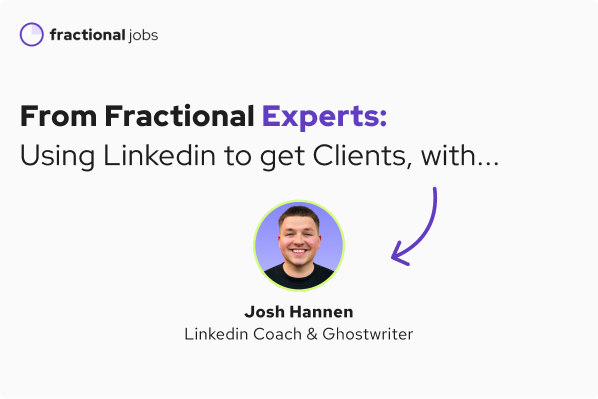How to Post on LinkedIn Without Being Cringey

Josh Hannen is the LinkedIn coach for Fractionals Execs. Backed by a decade spent growing audiences, he teaches fractionals how to win clients from LinkedIn. His LinkedIn Lead Engine program recently helped a fractional COO drive 11 qualified leads after just 5 weeks in the program.
If you want help building your own LinkedIn Lead Engine, book a free discovery call this month & he’ll walk you through how it works.
Let’s be honest…
When you think about posting on LinkedIn, your first thought isn’t the value you’re about to deliver.
It’s that quiet worry: “what if this makes me look cringey?”
You’re not thinking about your audience or your strategy.
You’re imagining people you know reading it.
Colleagues judging it.
Potential clients misunderstanding it.
That exposed feeling of putting yourself out there.
The “fear of cringe” is what keeps so many smart, capable people silent on a platform that could genuinely change their business.
Give me a minute, and I’ll show you exactly what creates that “cringe” feeling and how to make sure it never holds you back on LinkedIn again.
Step 1: Understand What Cringe Really Is
I don’t think people are actually afraid of being cringe.
They’re afraid of being themselves.
Your fear of sounding cringe isn’t really about squirming with embarrassment.
It’s about recognising there’s a misalignment.
This happens when:
- you’re posting something that doesn’t sound like you.
- you’re forcing a “voice” you’d never use in real life.
- you’re either hiding your real self…
- or trying to be someone you’re not.
Cringe is the tension between the real you and the version you think LinkedIn wants.
And that’s why it feels unpleasant.
Your audience can sense it too.
Not because your post is bad, but because it feels fake.
On the flip side, the content that earns trust on LinkedIn is always rooted in three things:
- Your real voice
- Your lived experience
- Your ideal clients’ real problems
Not motivational pick ‘n’ mix, fake vulnerability, or overly polished thought leadership.
When you write authentically, cringe disappears, because nothing about it is performative.
Step 2: Learn How To Write Authentically
Here’s a few principles that genuinely work:
1. Back yourself.
- Find confidence in the value you have to share.
- You don’t need to be someone else.
2. Stop trying too hard.
- Posts that sound braggy rarely convert.
- You don’t need to force it.
3. Write how you talk.
- Clear points.
- Natural tone of voice.
- If you wouldn’t say it out loud, don’t write it.
4. Ground everything in lived experience.
- Tell the story behind your insight.
- Give the context only you could give.
- That’s what separates you from everyone else.
5. Speak to one person, not “your audience.”
- Imagine your ideal client is sitting across from you.
- What would you say to them?
6. Back up your points with proof
- People enjoy honesty.
- Share stats/screenshots/photos to prove your point.
When you stop trying to be someone else online and fully embrace the value you have to share, the fear will fade away and your ideal client will start trusting you much faster.
Cringe only exists when you’re pretending.
Want Help Showing Up on LinkedIn?
If you’re ready to stop second-guessing your posts and start showing up as the version of you your clients already trust in real life, that’s exactly what we do inside The LinkedIn Lead Engine.
It’s my 1-to-1 coaching program for Fractional Executives who want clear positioning, a consistent content system, and a writing voice that feels natural.
If you want support building your own inbound-driving LinkedIn engine, book a free discovery call and I’ll walk you through how we’d build it together.
👉Book here by 23rd Nov to claim $900 off the full program (FractionalJobs exclusive).
What to Read Next
Want to Read More?
Send fractional jobs,
playbooks, and more to

.svg)
.svg)